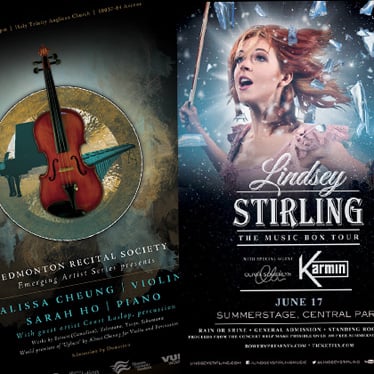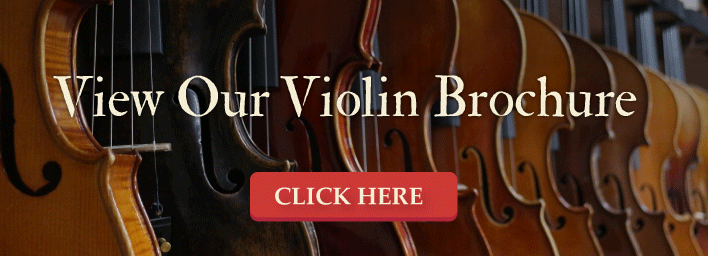7 Tips for Creating a Great Performance Poster

osters and flyers are the number one way of getting the word out about your upcoming event. You will use them not only to hang in store windows and bulletin boards in your community, but to brand your entire event on social media, websites, and more.
If you have the funds, hiring a professional graphic designer is the way to go. They can create beautiful professional graphics based on your vision – or help you develop a concept for your concert. If you’re on a tight budget, you might consider doing it yourself. Either way, you don’t want to make just a poster – you want to make an eye-catching statement.
Here are a few tips to get you started
1. Online tools that help you design
If you’re going the DIY route, there are some online resources to take advantage of, such as Word Swag, PosterMyWall, and Canva. It doesn’t beat a professional designer's eye, but if you’re trying to get a poster or web image made for zero dollars, and pronto, they’re good solutions.
2. Start with size
Typical posters are 11x17, 12 x18, or larger. But, it is always important to consider where the poster will be hanging. Most shop windows prefer the 11x17 size so they can accommodate all their display requests. You may be turned down to hang your poster if it is too large.
In most cases, you’ll be printing your poster as a postcard or flyer as well, so it's important when planning your main poster image that is will resize well and keep its visual impact.
In terms of scale you may want to:
- Make a shareable image for social media
- Make a postcard or flyer to hand out
- Make a web version for your website's landing page
- Create a web version that can be sent as an e-blast
- Re-scale for print media ads
3. Image is everything
The most important aspect of your poster, or show announcement, is its central image. You want something dynamic that will stand out from other posters, especially when it will most probably be hanging next to many others.
Going clean and straightforward in your design with a standout image is ideal. You want someone to see it from afar and want to look closer. Or, you want someone to desire to take it home and keep it. So, the image is everything.
Think about the style of the performance for a theme in your visuals
One option is to have your poster reflect the theme of your performance. That can be graphics that replicate the era or period of the piece(s) you’ll perform.
Color
Choose complementary colors. You don't want your poster to look like a circus, making it visually hard to tell where the pertinent information is located. Stick to clean and simple design with a focus on the main image and details of the event, all in complimentary colors.
Highlight the Performer
Another option is to highlight the performer. If possible, choose a publicity photo that is compelling or that represents how they appear on stage, so audiences already feel connected to the performer before the actual event.
That’s a perfect segue to the importance of publicity images. If you haven’t had professional photos taken yet, now’s a good time to do that. Thinking about your personal performance persona, get photos taken that show you in the types of clothing, costumes, backdrops, etc., that replicate your brand and/or the type of performance or program you’ve selected. Also consider the mood and emotional quality the poster will convey.
4. Important details
The goal of your poster is to simultaneously pack a compelling visual punch and deliver critical information points with a quick optical scan. Achieving that makes your poster translatable across both physical print and digital/social media outlets.
Make sure it covers the essential Call-to-Actions:
- A title or a micro-description of the performance (i.e., Joshua Bell Plays Beethoven)
- The date/time/place
- Where to buy tickets (brick-and-mortar and online links)
- Your website address and/or the venue’s
- Be sure to list any sponsors and their logos
- Social media info
On social media, don’t forget to format the digital hyperlinks so followers and subscribers can click-thru.
5. sharing via social media
As mentioned above, scale down the image so it can be shared via social media, look great on the “upcoming events” page of your website, shared via email, or can be printed in postcard/flyer size.
Share the poster on FB, Twitter, Instagram, and any other social media platforms
Social media is the most prominent way to share information about your events with an exponential number of followers. If you haven’t done so yet, create professional accounts/profiles on all of the standard social media platforms and start sharing with your network.
Consider ticket giveaways for followers that share promotional posts to 10, 20, or 50 followers, to generate extra buzz and grow your network.
6. Promote at the Venue
Increase your exposure by getting the venue to post the image on their social media accounts. Don’t be shy about sharing your information on the venue's social media posts. They are interested in growing their audience membership too, so combining networks is as beneficial to them as it is for you.
7. Don’t forget the press
Consistent self-promotion can take some getting used to, but it’s a prerequisite for getting your name out there and cultivating an ever-increasing fan-base. While social media is excellent, don’t forget traditional press venues either. This can be either a print media ad or be picked-up in the "coming events" section of your local paper.
Read, How to Write Your Press Release & Bio. The tips offered there will support your press relationships, which can help publicize your upcoming event by having them reprint your poster or concert announcement.
Designing a great performance poster expands your audience base and generates a buzz. Use these tips to get your juices flowing and get creative!
Poster images above courtesy of sweetladydesigns.com and behance.net


